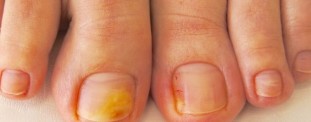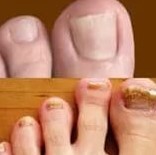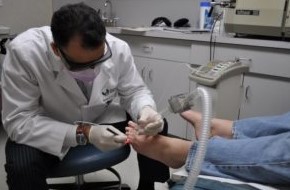Fungal infection on toe nails are common. There are different types of fungus toenails and the treatment depends on the type of pathogen. The cause of the disease is not lack of hygiene, but that many have throughout the working day to be in the shoes.

The essence of the infection and progression of the disease is in contact with fungal spores dead skin. Microorganisms penetrate into all cracks, bumps, roughness, damage. In almost all cases the fungus passes on the nails, which immediately begin to take on an unhealthy appearance.
Principal
Itching, a change in the nail plate is a common symptoms that are observed in all its forms. There are more specific signs depending on the type of pathogen. So, what types of fungus are there?
Dermatophyte
This form develops in contact with the pathogens Trichophyton, Microsporum and Epidermophyton.
Man is faced with the following symptoms:
- the appearance of gray, yellow bands on the plates. First spots appear on a single nail, moving onto a nearby;
- the nail gradually starts to lag behind the bed.
Molds
Mold is able to affect not only products, but also skin and nails. The main symptom of this form of fungal disease is change the color.
With a healthy pink hue they become nasty in black, brown or green. No less common symptom is the appearance of blackheads, spots.

Yeast
Occurs due to the fungus infection Candida. A negative feature is the high probability of defeat full stop. The main symptoms include:
- The nail surface becomes much thinner, which makes them break down faster.
- Nail plate to change color and structure.
- With the development of the disease there are more powerful exfoliation.
- Fingers constantly swell and become red.
This infection spreads through moisture. For this reason, it is important to follow certain preventive measures when visiting swimming pools, public shower.
Classification by stage of development
To assign the most effective treatment, the physician must determine what degree of development reached the disease, that is, to correctly determine the stage of the fungus on the feet. With the development of the infection pathology is beginning to spread not only to nearby nails, but also on the skin, affecting the whole foot.

Forms of the disease based on the stage of its development:
- Normotroficheskie, in which there is a change in nail colors and lines appear, but the form itself does not change. This is the initial stage of infection.
- Hypertrophic, which has changed the nail. He very easily breaks down, becomes thin, thereby bringing the patient great inconvenience.
- Atrophic. The plate in this case is much thinner, it fades, the shape, the nail is bent and is rapidly destroyed. At this stage, the nail plate begins to move away from the bed. The treatment here is quite severe, as the disease begins to take on running form.
Competent therapy
To get rid of the disease is possible only with the help of a competent therapy. It depends on the type of fungus and will have to rely on the stage of the disease.
The doctor conducts a medical professional examination, determines the form and type of fungus, studying the individual characteristics of the organism and prescribes treatment.
The selection circuit
Medicine offers three main treatment regimens – systemic, holistic and therapy external means. In the first case it is assumed the intake of medicines in form of tablets or capsules. Many of them have a large number of side effects.
In complex therapy treatment not just tablets, but also local drugs. When the outer is minimum number of side effects, because this scheme is preferable.
An important point topical treatment – it helps only at the initial stage of the disease, that is, if affected, less than one third of the nail plate and no more than two toes.

During treatment at all stages and in all forms are assigned to different external treatment methods. We are talking about creams, lacquers and solutions. The varnishes have an effect exclusively on nail fungus on the feet, without affecting nearby tissue.
Among the external means of treatment often used different creams. Not only do they effectively eliminate all pathological signs, but also soften and moisturize the nails, reducing the indicators of discomfort. Regardless of the chosen method of treatment of fungus and preparation is very important to follow the instructions of the specialist and the medication. The only way to achieve positive results of treatment. The only way the treatment will provide an antifungal effect and an optimal antibacterial effect.
The number of applications and techniques depends on the drug and on the type of mold and the shape of its development. Usually, it is two to three times a day.
If you use external remedies for the treatment of fungus before each application should be removed with special tools keratinized. This will increase the penetrating ability of the drug, helps a lot faster to achieve a positive effect, regardless of the type of fungus.
Summing up
The total duration of therapy of fungus, the average is 6 months, and only then observed the growth of healthy updated nail plate. To achieve this result the treatment is usually not end, it must continue until, until you reach a long lasting effect and will not completely prevented recurrence of the disease.





























